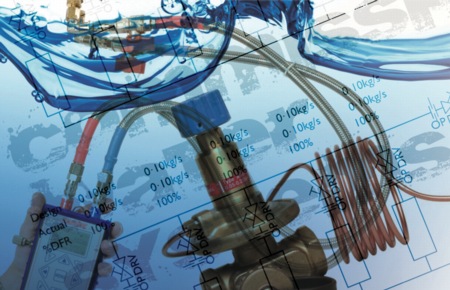Beyond proportional balancing

The move towards variable-flow systems has seen the need for new approaches to maintaining flow rates in systems. BSRIA’s Mike Smith and Chris Parsloe look at how to set up and control such systems.
Proportional balancing is a fundamental requirement for re-circulating pipework systems. It is defined in CIBSE/BSRIA guides as ‘the process of bringing the fluid flow rates throughout a distribution system into balance with one another, in their correct proportions and within the tolerances specified by the designer’. This precise definition reflects the fact that there has always been more to proportional balancing than simply setting the flow rates to their design values.
In an hydronic system fitted with manually operated regulating valves, achieving a balance is made complicated by the fact that every adjustment of the flow through one branch affects all the flows through the other branches. To be effective, therefore, the balancing process has to follow a particular methodology. This process involves starting from system extremities and adjusting valves in turn, working back towards the pump.
This situation is changing due to the trend towards variable-flow systems. Proportional balancing is essential in systems with manually adjusted regulating valves, but such valves are of little use in variable-flow systems where pressures and flows are intended to vary all the time. For this reason, valve manufacturers have developed a range of self-acting valves that automatically adjust their settings. Most of these valves operate by means of a spring-loaded plug, the position of which varies depending on system pressures.
The simplest self-acting valve is a constant-flow regulator. This type of valve varies its resistance such that the flow through the valve is maintained at a constant value.
Some constant-flow regulators include specially designed cartridges that automatically set the flow to the required value as soon as the pumps are switched on.
Another type of valve is the adjustable differential pressure control valve, which holds pressure constant across a fixed resistance.
With both valves, there is no need for a proportional-balancing process. Balancing is reduced to the simple setting of the valve and, if required, a measurement of flow to confirm the set value.
Although constant-flow regulators are useful in systems with on/off control they do not operate well in systems requiring modulating control of flow rates. In simple terms, modulating control performance is spoilt if, when 2-port valves begin to close, constant-flow regulators simultaneously open to correct the flow.
A more common alternative is, therefore, the differential-pressure control valve (DPCV). This type of valve maintains a constant differential pressure between branch flow and return pipes. This means that 2-port control valves can close against a fixed and limited pressure differential as set by the DPCV. This helps to ensure that they never need to close against excessive pressures, which might cause noise, and also improves their authority (i.e. their ability to influence flow rate). DPCVs need to be adjusted to achieve the correct design flow rate through the branches in which they are located, but there is no need for a proportional-balancing process. Once set, the flow through a DPCV is unaffected by valve closures elsewhere or variations in pump speed.
Although DPCVs improve the performance of variable-flow systems, they should ideally be located as close as possible to the 2-port control valves they protect. If located on main branches some distance away from the 2-port valves, the differential pressures they maintain may still be too high to properly protect the control valves. With this in mind, valve manufacturers have concluded that the DPCV should ideally be integrated with the 2-port control valve.

This new type of valve is commonly referred to as a pressure-independent control valve (PICV). This is because the action of the 2-port control valve is independent of pressure variations elsewhere in the system owing to the fact that an integral DPCV maintains a constant pressure differential across the control valve plug and seat. In the same way as for a DPCV, the valve must be set to its design flow rate, but there is no requirement for proportional balancing. Furthermore, because the 2-port control valve is fully open during commissioning, the DPCV is effectively holding pressure constant across a fixed resistance. In this condition the valve acts like a constant-flow regulator, and flow settings can be incorporated on the valve body to assist setting.
It can be seen that DPCVs and PICVs in particular, offer the potential for improved control of flow rates in variable-flow systems and replace proportional balancing with a simple process of setting flows.
Each of these valves and their commissioning requirements are described in ‘BSRIA Guide BG2/2010: Commissioning water systems’. Their application in systems is described in ‘BSRIA Guide 12/2011: Energy-efficient pumping systems’.
There is currently no standard test method that deals specifically with these types of valve. In support of these products, BSRIA is working on a standard test procedure for the evaluation of PICVs and is working with manufacturers to ensure that such a procedure will benefit the industry and the end users.
This new standard test procedure is based on the existing EN standards and should allow direct comparison of valve performances to provide information to designers and end users so they can make an educated choice when specifying and purchasing such products.
The test results obtained can be compared with the designer’s specification and calculations against manufacturers’ technical data and recommended pressure differences. Hence the published data for supplying constant flow rates of fluid through a system can be analysed effectively.
The new standard test procedure is expected to be approved by the industry and published by BSRIA in June 2011, enabling BSRIA to start performance evaluation of those products in its test laboratory in Bracknell.
Mike Smith is engineering director with BSRIA, and Chris Parsloe is an associate.








